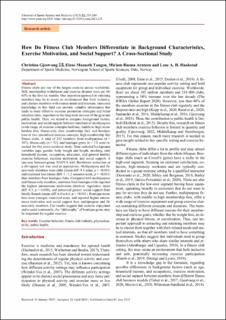| dc.description.abstract | Fitness clubs are one of the largest exercise arenas worldwide. Still, membership withdrawal and exercise dropout rates are 40-65% in the first six months. One important approach to retaining members may be to create an environment that feels inclusive, and clusters members with mutual needs and interests. Increased knowledge in this field can provide valuable information that leads to more effective exercise promotion strategies and better retention rates, important to the long-term success of the gym and public health. Thus, we aimed to compare background factors, motivation, and social support between members of multipurpose (wide range of exercise concepts/facilities, middle to high membership fee), fitness-only (low membership fee), and boutique (one or two specialized exercise concepts, high membership fee) fitness clubs. A total of 232 members from multipurpose (n = 107), fitness-only (n = 52), and boutique gyms (n = 73) were recruited for this cross-sectional study. Data included background variables (age, gender, body weight and height, smoking, total household income, occupation, education, and general health), exercise behaviour, exercise motivation, and social support. A one-way between-group ANOVA with Bonferroni correction or a chi-square test was used as appropriate. Multipurpose and fitness-only members were older (mean diff: 9.1 years, p = <0.001) and exercised less (mean diff: 1-1.2 sessions/week, p = <0.001) than members from boutique clubs. Compared with multipurpose and fitness-only members, members from boutique clubs reported the highest autonomous motivation (intrinsic regulation: mean diff: 0.3, p = 0.030), and perceived greater social support from family/friends (mean diff: 6.4 to 6.6, p = <0.001). Boutique members were younger, exercised more, and reported higher autonomous motivation and social support than multipurpose and fitness-only members. Our results suggest that exercise enjoyment and a social community, the “philosophy” of boutique gyms, may be important for regular exercise. | en_US |
